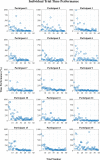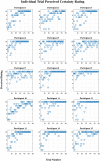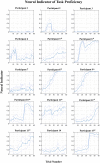Toward a Subject-Independent EEG-Based Neural Indicator of Task Proficiency During Training
- PMID: 38234308
- PMCID: PMC10790941
- DOI: 10.3389/fnrgo.2020.618632
Toward a Subject-Independent EEG-Based Neural Indicator of Task Proficiency During Training
Abstract
This study explores the feasibility of developing an EEG-based neural indicator of task proficiency based on subject-independent mental state classification. Such a neural indicator could be used in the development of a passive brain-computer interface to potentially enhance training effectiveness and efficiency. A spatial knowledge acquisition training protocol was used in this study. Fifteen participants acquired spatial knowledge in a novel virtual environment via 60 navigation trials (divided into ten blocks). Task performance (time required to complete trials), perceived task certainty, and EEG signal data were collected. For each participant, 1 s epochs of EEG data were classified as either from the "low proficiency, 0" or "high proficiency, 1" state using a support vector machine classifier trained on data from the remaining 14 participants. The average epoch classification per trial was used to calculate a neural indicator (NI) ranging from 0 ("low proficiency") to 1 ("high proficiency"). Trends in the NI throughout the session-from the first to the last trial-were analyzed using a repeated measure mixed model linear regression. There were nine participants for whom the neural indicator was quite effective in tracking the progression from low to high proficiency. These participants demonstrated a significant (p < 0.001) increase in the neural indicator throughout the training from NI = 0.15 in block 1 to NI = 0.81 (on average) in block 10, with the average NI reaching a plateau after block 7. For the remaining participants, the NI did not effectively track the progression of task proficiency. The results support the potential of a subject-independent EEG-based neural indicator of task proficiency and encourage further research toward this objective.
Keywords: EEG; classification; cognitive state prediction; passive brain-computer interface; spatial knowledge acquisition; subject-independent.
Copyright © 2021 Kenny and Power.
Conflict of interest statement
Financial support for the conduct of the research was provided by the Research and Development Corporation of Newfoundland and Labrador (RDC) and the Natural Sciences and Engineering Research Council of Canada (NSERC). The sponsors did not have any involvement in the study design, data collection, analysis or interpretation, report writing, or the decision to submit the article for publication.
Figures






References
-
- Andreessen L. M., Gerjets P., Meurers D., Zander T. O. (2020). Toward neuroadaptive support technologies for improving digital reading: a passive BCI-based assessment of mental workload imposed by text difficulty and presentation speed during reading. User Model. User Adapt. Interaction. 10.1007/s11257-020-09273-5 - DOI
-
- Appel T., Sevcenko N., Wortha F., Tsarava K., Moeller K., Ninaus M., et al. (2019). Predicting cognitive load in an emergency simulation based on behavioral and physiological measures, in 2019 International Conference on Multimodal Interaction (Suzhou: ).
LinkOut - more resources
Full Text Sources

